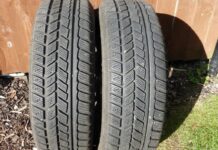Winter tires can be installed on your vehicle in October, and taken off in April. They will protect you from any potential dangers that could arise due to adverse weather conditions throughout the winter season. Winter tires are able to grip snowy or icy surfaces and can withstand harsh winter conditions. They can also be safely used on both dry and wet surfaces with no degradation in performance. On wet surfaces, it minimizes the risk of aquaplaning (aquaplaning) by evacuating the water in the fastest way and ensuring that the tire's contact with the road is continuous.
Because of the tread mix used, winter tires wear out faster than other tires. Also, the noise level is higher when winter tires are used in the summer.
Tires with tread depths of less than 1.6mm should not be used. In winter, it is important to make sure that the tread depth is at minimum 3mm.
Winter tires should be taken out of vehicles by March-April at end of winter season. They should then be stored in a dark, damp place for next season. It should be placed on the balcony of the house in a thick nylon bag.
Their main advantage is their ability to withstand winter conditions. They have a special backing that will not lose its properties in low temperatures. The tread pattern’s toothed structure and shoulder blocks provide additional traction for snowy surfaces. You can also use silica tread mix and sipe-channel block structures to provide excellent handling on slippery surfaces.















